True Stories
Page 35 of 42
 Ericson 38 - Sail Trim
Ericson 38 - Sail Trim
Editor’s note: Final in a series of emails working out performance issues with the Hydrovane. The problem was sail trim – probably a big genoa that filled and folded upsetting the ‘balance’.
From: Mark Reed
Sent: December-14-09 5:00 PM
To: Will Curry
Subject: Re: Our trip South with a Hydrovane
We really put the vane through its paces today. Deep reaching in 20kts, steep 6′ seas, heavy surfing. Gradually altered course to windward (using the Hydrovane) as we entered Magdalena Bay, crossed a significant current line, ended up beating hard to windward double-reefed. Hydrovane performed flawlessly on all points of sail, now I totally trust it. We will be getting that large genoa cut down or off the boat!
Thanks for enduring my panic attack: Let me know if there are any specific pictures, reports you would like, and thanks again for the assistance!
Mark
Contact Kaufman 43
Kaufman 43
“The Hydrovane does the driving 80/90% of the time offshore – a brilliant bit of kit.”
“This is the second one I have had…”
Sent: February-05-10 1:24 AM
To: John Curry
Subject: Re: Stormy Monday is a? Frers design? Swan?
Hi John
Stormy Monday is a Kaufman 43 – designed by Mike Kaufman in Annapolis but built in Taiwan. Only about 6 or 7 ever built I believe.
The Hydrovane does the driving 80/90% of the time offshore – a brilliant bit of kit.
This is the second one I have had – the last one was on an S&S 36 in which it helmed for 5 transatlantics & I understand has done 2 more since.
In my time the only thing ever to be replaced were vane covers.
Keep up the good work!
Regards,
Paul
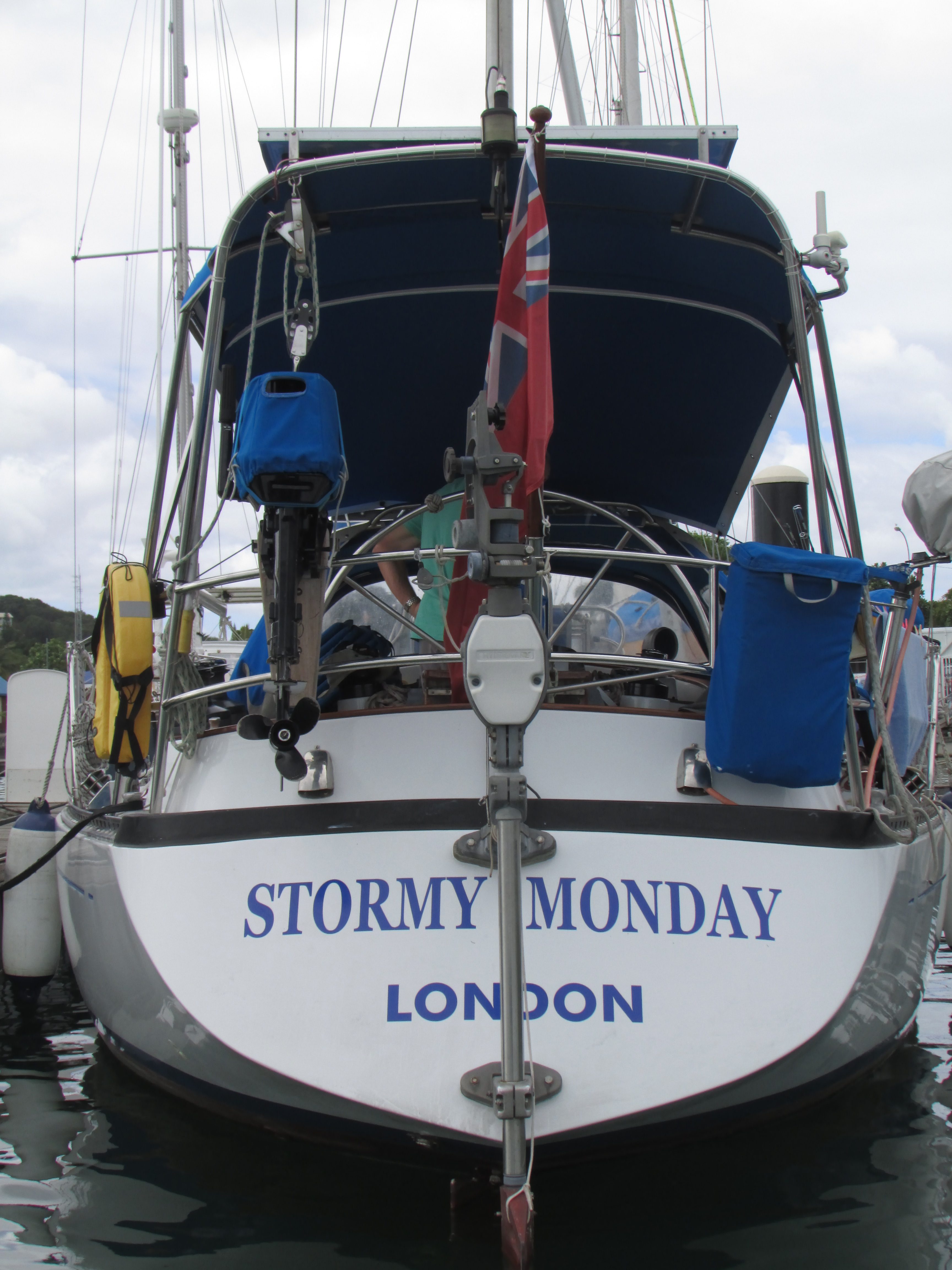
 Pearson 35 to Overseas 40
Pearson 35 to Overseas 40
“…my love affair with the hydrovane continues…”
“Just as in Raitea with my previous boat and the same hydrovane, we left the dock with no sea trials, activated the unit, and sailed to New Zealand from where I am writing. Except for some hours under power, the hydrovane sailed the whole way.”
From: Daniel Paull
Sent: December-15-09 5:48 PM
To: John Curry, Will Curry
Subject: Hydrovane Installation
Dear John and Will,
I am writing to thank you for your assistance with my hydrovane installation. We communicated in August and you were both extremely helpful.
The hydrovane unit is one I installed on my Pearson 35, Glide, several years ago and I removed and kept for installation on my new boat, an OverSeas 40, Noomi, when I sold the Glide in Fiji. With your encouragement and advice I did the installation off center and through my stern platform. I used all of the old components without a longer shaft. In order to do that without compromising my boarding ladder, or having the unit very far off center, I had to mount the unit in such a way that the emergency tiller impinges upon the stern rail and therefore cannot be fitted. (Of course, the emergency tiller is not necessary for emergency steering with the hydrovane rudder.)
I am extremely pleased with the installation and my love affair with the hydrovane continues: I did the installation in New Caledonia, in multiple stages both in the water for the H mount and out of water for the E mount (which is below the stern platform). Just as in Raitea with my previous boat and the same hydrovane, we left the dock with no sea trials, activated the unit, and sailed to New Zealand from where I am writing. Except for some hours under power, the hydrovane sailed the whole way.
I will attach some pictures of the installation and a picture of another boat to which we were rafted up in Whangerei, New Zealand, which shows an interesting juxtaposition of HE and EH installations. The owner of Stormy Monday, who sailed her to New Zealand from Great Britain is also very happy with his hydrovane. Again, thank you very much for your support and please quote me as you see fit.
Daniel Paull
SV Noomi
Whangarei, New Zealand
Contact
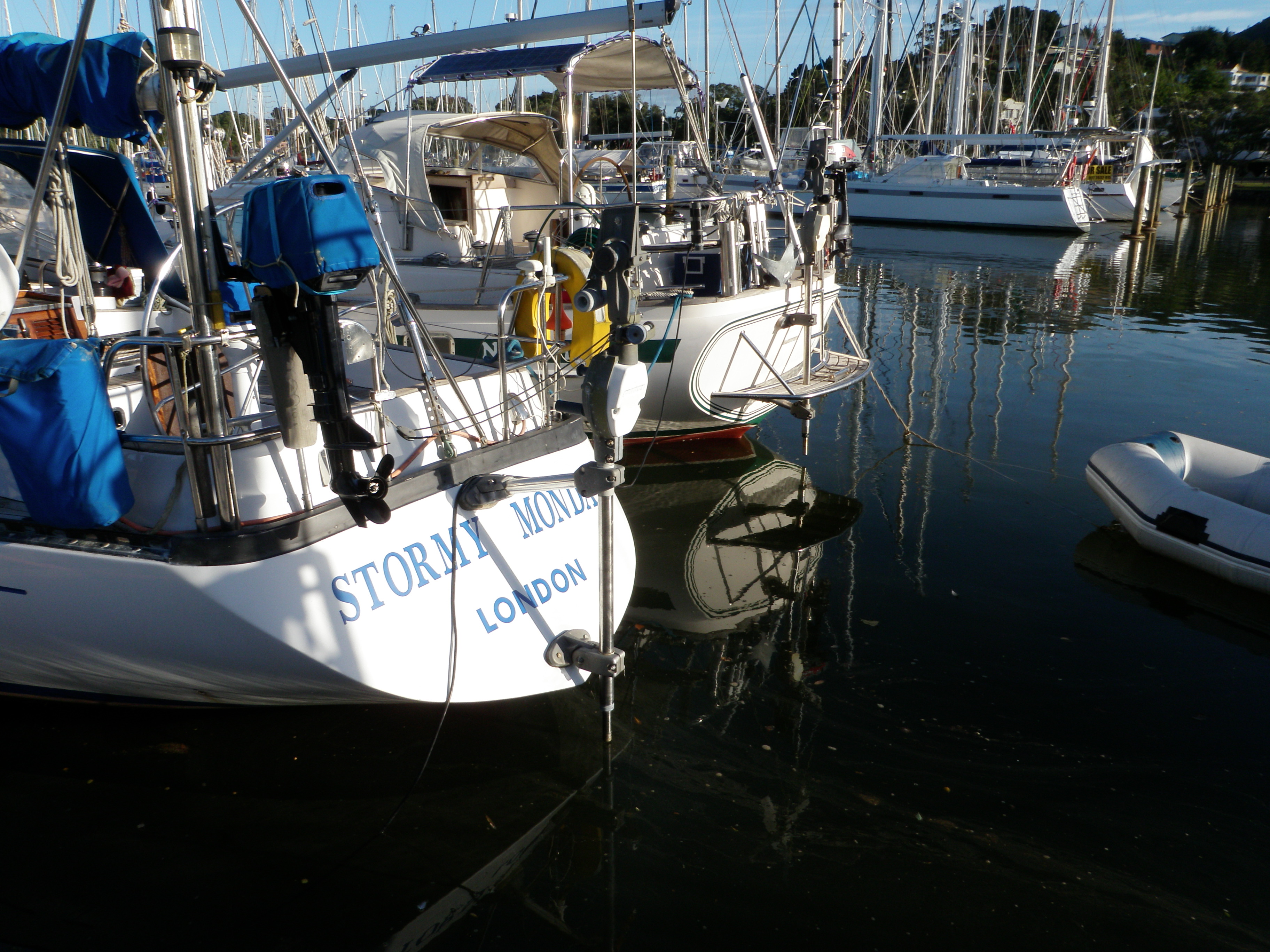
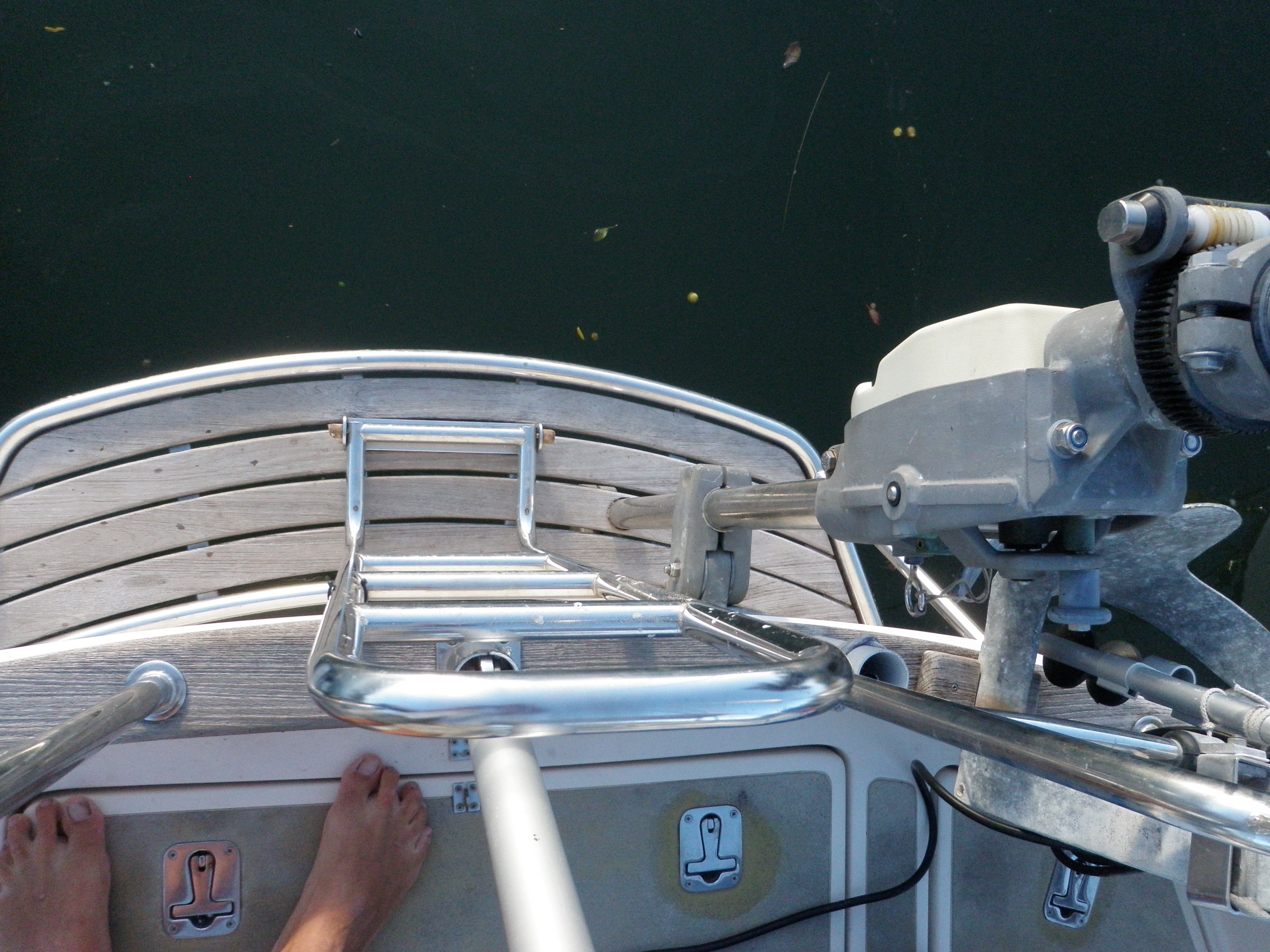
 Shin Fa 458 (aka Liberty 458)
Shin Fa 458 (aka Liberty 458)
“I know you have heard this in the past from many of your customers, but your Hydrovane far exceeded any of our expectations…”
“…since we weigh in at close to 50,000 pounds, I think he can handle any boat.”
From: Bill & Tracy Hudson
Sent: December-09-09 6:46 AM
To: john@hydrovane.com
Subject: Our trip South with a Hydrovane
I know you have heard this in the past from many of your customers, but your Hydrovane far exceeded any of our expectations as we sailed south along the Baja coast.
We installed it in Port Townsend and never got the chance to use it until we got South of the border and hit Mexico. Once we set him up he set us straight in light winds and in good winds. Anywhere from 4 to 15 knots, he did just great.
We put up all our sails–Main, Genoa and Forestaysail and he kept us on course. We tried with the Spinnaker alone and he kept us on course just great.
When we were about 150 miles North of Cabo, our hydraulic steering failed (leak in the lines) and we hoisted the sails again and the Hydrovane took over and took us to right outside the harbor without a peep.
What a great piece of equipment for any sailboat. I’d been told by more “experienced” sailors that all wind vane steering systems were a bunch of hype sold at shows, but yours has shown to be a champ in our eyes and since we weigh in at close to 50,000 pounds, I think he can handle any boat.
Thanks for the great new crew member for our boat. Nice to have someone on board that stands many watches and keeps us on course (and doesn’t eat anything).
Bill & Tracy Hudson
Shin Fa 458 (aka Liberty 458)
PS – We love our new Hydrovane. We even named him “James” as he is our chauffeur that always takes us home (“Home James”).
Contact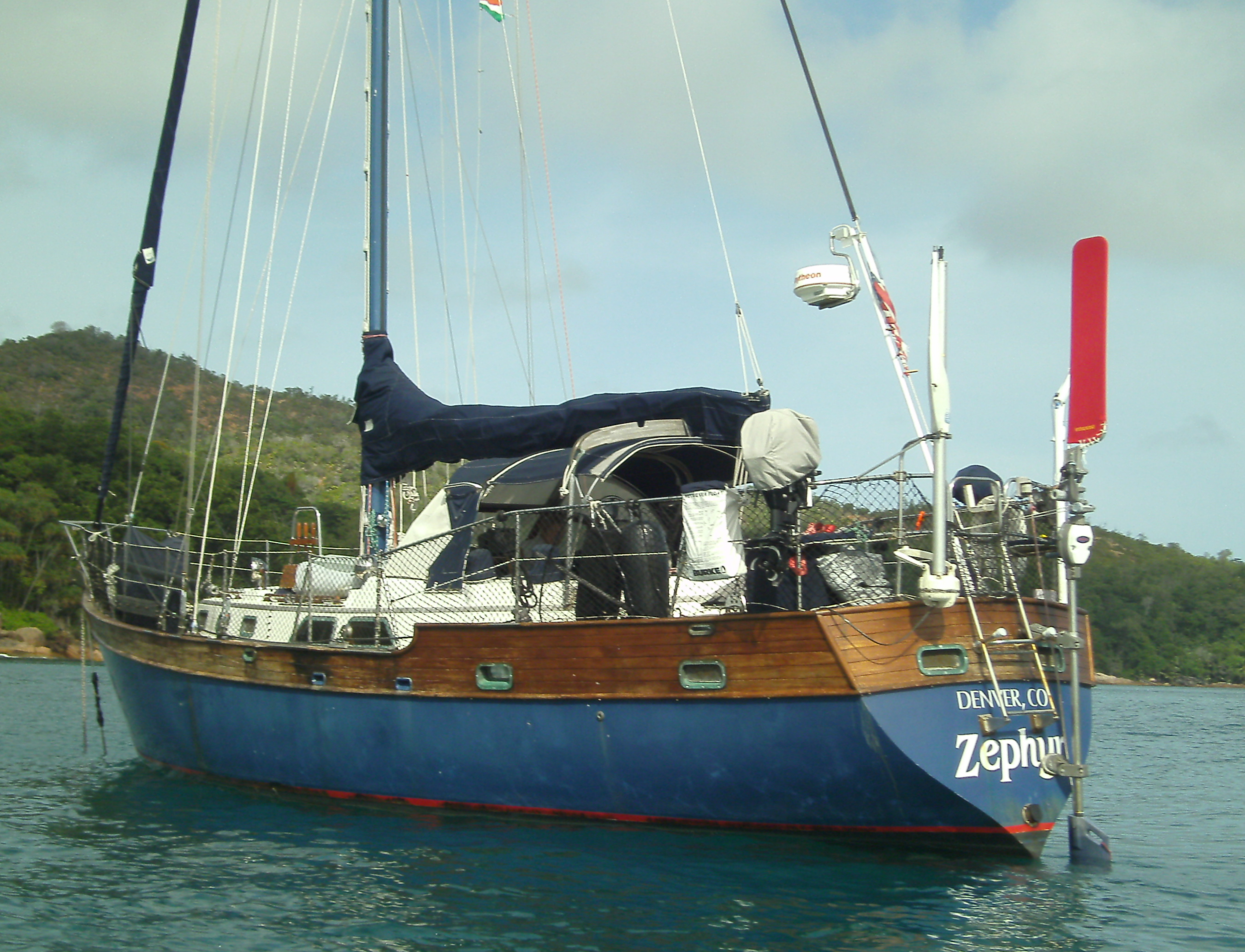
 Beneteau 423
Beneteau 423
A hitchhiker!
From: Chris Marchant
Sent: December-08-09 2:52 PM
To: John Curry
Subject: Hydrovane Egret
Hope you like these pics. We were over 1000 miles from land en route to Barbados when these were taken. As I write he is still with us 500 miles later! We believe he is a cattle egret blown offshore. Our boat is a Beneteau 423.
Incidentally the Hydrovane was working well in these pictures!
Chris Marchant
PS Sadly I have to report the death of said egret
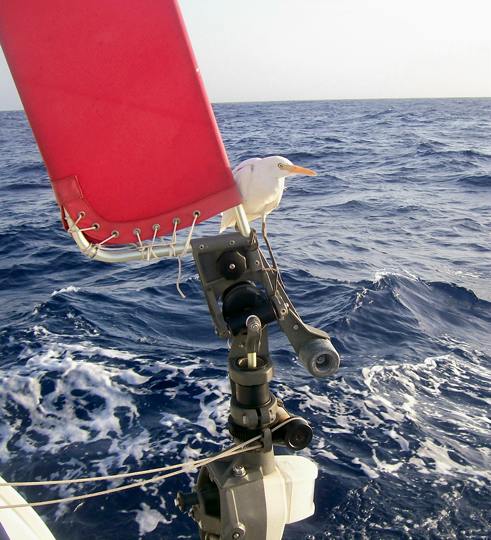
 Young Sun 35
Young Sun 35
“I wouldn’t consider any other windvane steering unit.”
I installed a Hydrovane on my previous boat (1983 Young Sun 35 — marketed in Europe as a Westwind 35) and it worked perfectly. I wouldn’t consider any other windvane steering unit.
Thanks for engineering such a great product!
Neal
 Caliber 40 LRC
Caliber 40 LRC
“The silence in the cockpit from the lack of autopilot was pleasantly notable.”
From: Jeffrey Kornblum
Sent: November-12-09 6:50 PM
To: ‘Will Curry’
Subject: Performance
Will,
I have just returned from two weeks on my boat in the Charleston, SC area. We sailed using the Hydrovane daily with winds ranging from 10-20 kts. I was impressed with how well it kept us on course. I expected more fluctuation in course as the wind picked up but it held us quite steady. We sailed one day with just the main to see how it would behave and it was right on.
The silence in the cockpit from the lack of autopilot was pleasantly notable. Sorry we didn’t have it before our cruise to the Bahamas but will look forward to our cruise to Bermuda next spring.
Regards,
Jeffrey Kornblum, M.D.
S/V Ko Olina
 Nicholson 32
Nicholson 32
“The Hydrovane made longer passages much easier and I felt that the boat was sailing better than ever.”
From: Chris
Sent: October-01-09 11:44 AM
To: John Curry
Subject: Re: Hydrovane
Hi John
We have just laid up after our first season with the Hydrovane and I can report that it fullfilled our expectations. We had a leisurely 2,500 mile cruise round Britain and experienced the usual variety of UK summer weather. The Hydrovane made longer passages much easier and I felt that the boat was sailing better than ever.
The only problem is that I have fitted the bottom bracket too low and so the bottom casting on the shaft drags in the water particularly when motoring.To solve this I intend to raise it by about 3 inches which will reduce the distance between the castings on the shaft to 16 inches. Is this ok? Is there a minimum for this spacing?
Thanks for a superb piece of kit. I wish I had fitted it earlier!
Best regards
Chris
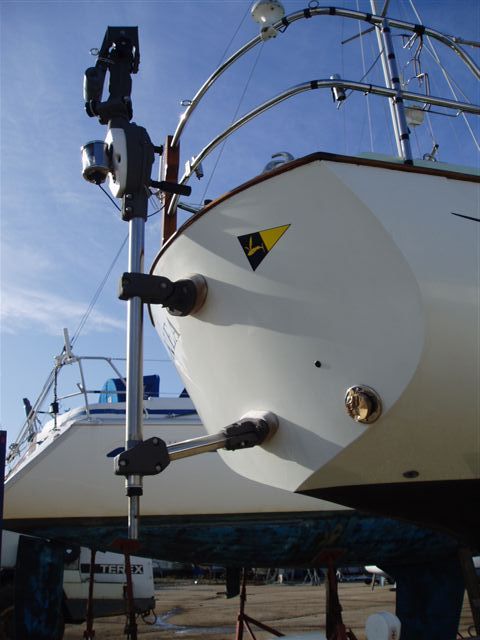
 Amel Maramu 46
Amel Maramu 46
“Removing the Hydrovane, deploying or retracting the swim platform and reinstalling the Hydrovane takes fewer than 10 minutes.”
From: Dennis and/or Virginia
Sent: November-05-09 11:02 AM
To: Will Curry
Subject: Hydrovane Installation
Hello Will,
Thought you might be interested in my solution for the installation of our Hydrovane on our 1982 Amel Maramu with a retractable swim platform.
I was seeking a relatively simple disassembly process to remove the Hydrovane in order to deploy or retract the swim platform. The “clamping” nature of the H brackets at top and bottom would require careful vertical realignment upon each removal/reinstallation exercise. Using the E bracket at the top mounting allows the establishment of a vertical registration anchoring point. However, as you may notice in photo # 3, I didn’t have quite enough clearance from the slope of the transom, thus I had to shave 3/4″ off the end of the casting. Having made this modification, I can now remove the Hydrovane (using a outboard motor hoist mounted on the stern pulpit) by removing the rudder and releasing three bolts. This is facilitated by hinged and removable slats in the swim platform. The additional hole cut into the platform slats provides flush retraction of the platform against the transom, allowing the reinstallation of the Hydrovane. Removing the Hydrovane, deploying or retracting the swim platform and reinstalling the Hydrovane takes fewer than 10 minutes.
We have employed the Hydrovane in several crossings to the Santa Barbara Channel Islands in a variety of wind and seas and are quite pleased with the ease of use.
Sincerely,
Dennis Johns
s.v. Libertad
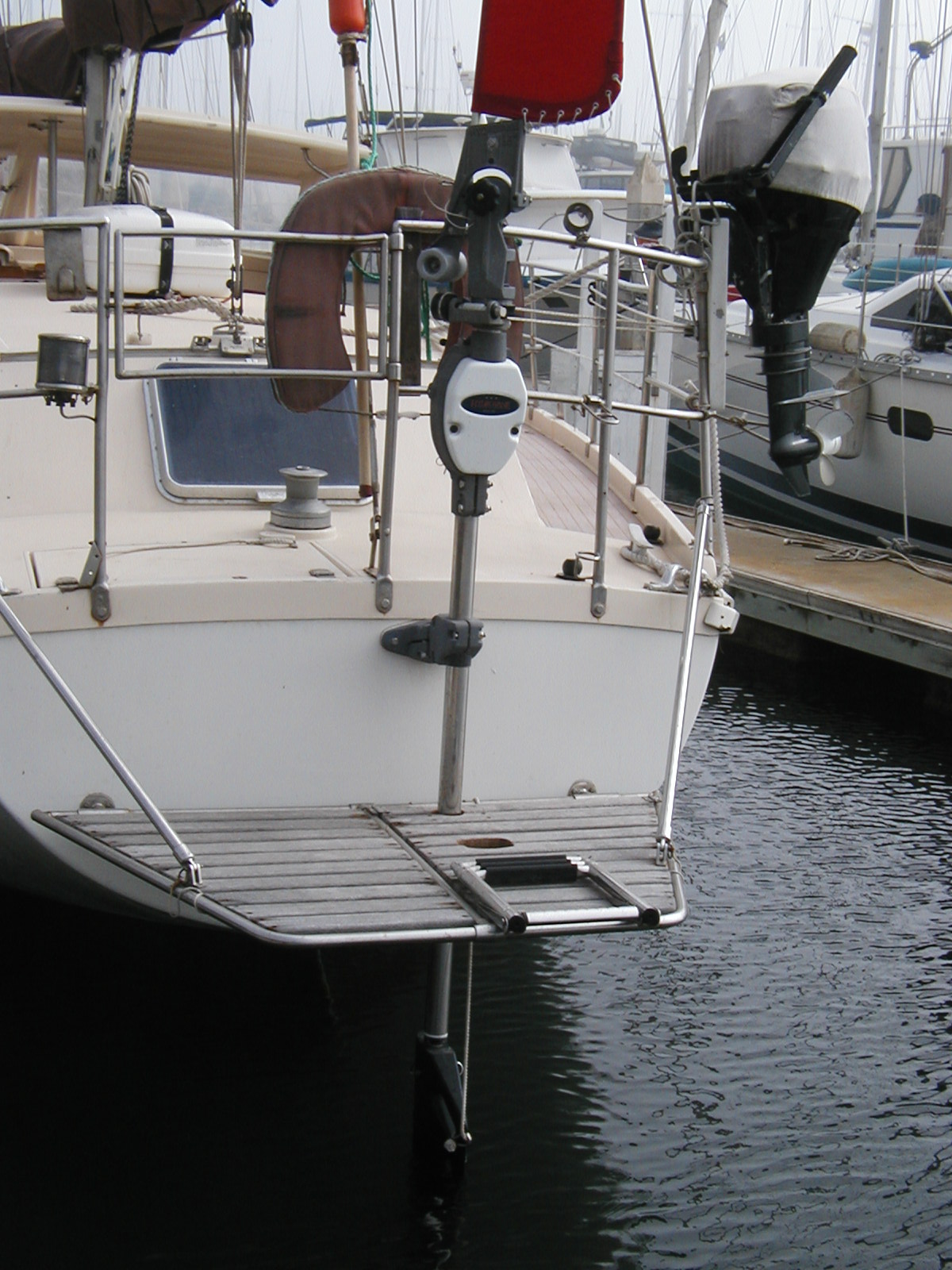
 Beneteau First 47.7
Beneteau First 47.7
“So the Vane is installed on the high end of performance sailing. Never was passed in over 2k and just loved to be powered up with the Vane steering swilling a beer while I passed crewed up boats working their butts off trying to keep ahead.”
From: Darryl Laurin
Sent: November-06-09 11:40 AM
To: John Curry
Subject: from Client Darryl Laurn S/Y Vimy
Hi John and Will
I apologize that it has taken me such a long time to send some feed back to you. First my Lap Top feed the fish in Barcelona and later my camera off the Ionian islands. And, I have sailed more or less solo from Gibraltar to here, Marmaris Turkey this summer. Not a lot of great wifi along the way!
In Review.My boat is a Beneteau First 47.7 or 48ft or 14.8 m. – weight only 11.3 tons – extremely fast yet with perfect sailing characteristic. I could not imagine single handing a better boat.
So the Vane is installed on the high end of performance sailing. Never was passed in over 2k and just loved to be powered up with the Vane steering swilling a beer while I passed crewed up boats working their butts off trying to keep ahead. The final blow was the big red Vane. I love it!
Installing on the 47.7 – could have used a cm or two more pipe for the upper and just made it – as you can see. MM between the drop down platform and the vane. It works but we stood off the transom lower fitting with wood. (which I epoxied to preserve)
Two of us put it together very quickly. The toughest part was being crunched up down in the transom answering the screws with bolts on the inside.
Sailing: As I have said this is high end fast sailing yacht – a Bruce Farr designed racer. I regularly sail to windward at 8.5 knots and downwind with just the main, 11kts is not difficult. I have used the Vane intensely. Indeed my so call bullet proof B & G hydraulic ram so beloved of the round the world folks crashed. I spent a month single handing the 15 m boat with just the vane. If there was a wisp of wind, I had the vane working and with this boat we could actually achieve a speed of 2kts in virtually no wind with the vane.
Sailing down the passage off Ithaca, it was a F5. The Vane maintained a correct track hour after hour and the wind was about 120deg. That far aft did surprise me. But as I say there was lots of blow.
Personally, I dumped the lines (of the remote course setting). I stand between the V of the support struts and move the wheel with my hand. The helm is so balanced it’s not even tied off until I am sure the Vane is happy.
I try and sell your product where ever I sail. Its great. And as an aside. I burn much less fuel and create much less Co2 as I don’t charge nearly as much as when I am on the B &G.
Thank you both for your input.
Fair winds,
Darryl Laurin
S/Y Vimy
(P.S.) having your vane is like being part of a club. Every time I see a vane its a sure thing that that crew will want to have a chat.
Contact
 Delphia 37
Delphia 37
“I can’t begin to think how it works… it just does!!”
From: Roy Goodman
Sent: September-04-09 1:04 AM
To: Will Curry
Subject: Re: Hydrovane for Delphia 37
Hi Will
…My new Hydrovane does exactly what it says on the tin – and it fitted round a central stern step and side bathing ladder! With the sails nicely set, you simply engage and enjoy the confidence of self-steering which results from quality engineering. I can’t begin to think how it works… it just does!!
Very best,
Roy
 Oyster 406 - Davits
Oyster 406 - Davits
“This set up works really well like this and the dinghy does not interfere with the Hydrovane – in fact the Hydrovane helps to keep the dinghy solid and stop it moving around.”
“I am now a Hydrovane convert and realise that it is one of the best purchases that I have made to prepare for our cruises.”
From: Ian
Sent: September-25-09 7:29 AM
To: John Curry
Subject: Re: Hydrovane
John
Hope you enjoyed the Southampton Show.
Here is the photo for your website. I include this one as it shows the Hydrovane in use with our dinghy to show that you can actually use the Hydrovane with a dinghy stowed in the davits – not a very windy day though! This set up works really well like this and the dinghy does not interfere with the Hydrovane – in fact the Hydrovane helps to keep the dinghy solid and stop it moving around.
When we were researching wind steering systems we couldn’t find any images of a Hydrovane fitted to a boat with davits – although you said this was possible – so you may find this picture useful in your marketing. If you need any more please let me know. Note also that the Hydrovane is slightly offset to allow us to use the centre gate to access the bathing ladder. Although the stern looks crowded it all fits pretty well together – the important thing was to plan everything!! I didn’t plan as well as I should have and very nearly made a significant mistake with regard to positioning but corrected it just in time.
Regards
Ian
From: Ian
Sent: August-28-09 8:30 PM
To: John Curry
Subject: Hydrovane
Dear John
We took delivery of our Hydrovane in Feb and installed it during Jun – these things always take longer than expected. But we have now left our home port in UK and are heading down towards the Med. I had never used the Hydrovane before and was slightly aware that this was a huge investment for something I had never tried. We have gone for a slight offset to give us access to the bathing steps.
On our channel crossing recently the wind was ideal to use the Hydrovane as we were pretty much close hauled for most of the way and needed to claw some distance up wind if possible. I had read the instructions but at the first attempt the Hydrovane took up the steering flawlessly – it was fantastic and took us all the way across the channel without any problem – far more comfortable and safer than if we had been steering and importantly without using any electrical power. We made a few course changes using the course correction line so we didn’t need to get out of the cockpit. I am now a Hydrovane convert and realise that it is one of the best purchases that I have made to prepare for our cruises.
Hope that you enjoy the Southampton show if you are over for that. I will not be there but will be at London in Jan so may see you there.
Regards
Ian
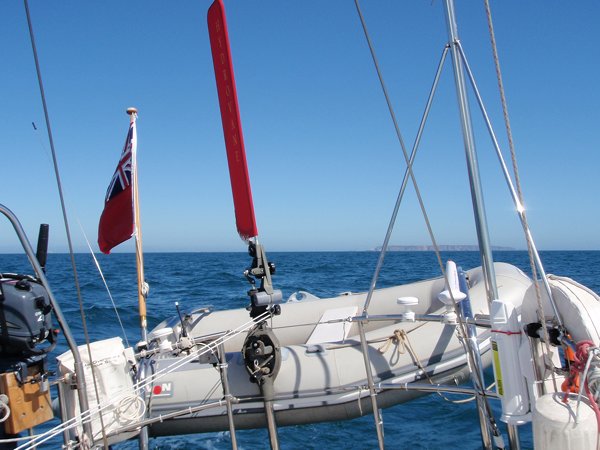
 Swan 38
Swan 38
“Harold is an amazing part of our crew on Roxi and to look aft and see the vane cheerily keeping us on course can be mesmerising. We use him upwind, downwind and even with our asymmetric spinnaker.”
Subject: RE: Hydrovane Parts for Swan 38
From: Alison Burnett
Date: Fri, September 11, 2009 8:39 pm
To: Will Curry
Hello Will
Sorry for the long delay, hope you had a good weekend
We bought our Hydrovane self-steering at the 2000 London Boat Show, once it was installed we christened him Harold after my grandfather who was a keen sailor but in his 90’s when we left for our first transatlantic cruise.
Harold is an amazing part of our crew on Roxi and to look aft and see the vane cheerily keeping us on course can be mesmerizing. We use him upwind, downwind and even with our asymmetric spinnaker
Have included some photos for your gallery:
The Old Harold:
We are in the Galapagos Islands, Simon is holding up the old vane with its patchwork of repairs telling its history, this vane took us on; one Atlantic circuit from Europe in 2000-2001, into the Med for 18 months – it didn’t get as much use during that trip, and then in 2006 from Portugal across the Atlantic again, through Venezuela to San Blas, through Panama, down to Ecuador and across to the Galapagos Islands. There in Isabella – our departure point for the Marquesas – in May 2007 we decided to treat Harold to the spare vane cover which we had stowed aboard.
The Atlantic 2006:
This our original vane cover with its many patched repaired still working happily to take us West
Tropical Sailing:
Our new vane cover with Harold beating towards Minerva Reef May 2008 So far the new one has taken us from Galapagos to NZ, then on a 4,000 mile trip up to Tonga and Fiji and back to NZ, we are still many miles from home so am sure the repairs needed in the future will start to have their own story.
We have no photos of our installation – which we are very happy with – and currently ‘Harold’ is not attached to Roxi’s stern as we will be painting our hull, if you would be interested we can send some at the end of the year when our refit should be completed.
Best wishes
Alison and Simon
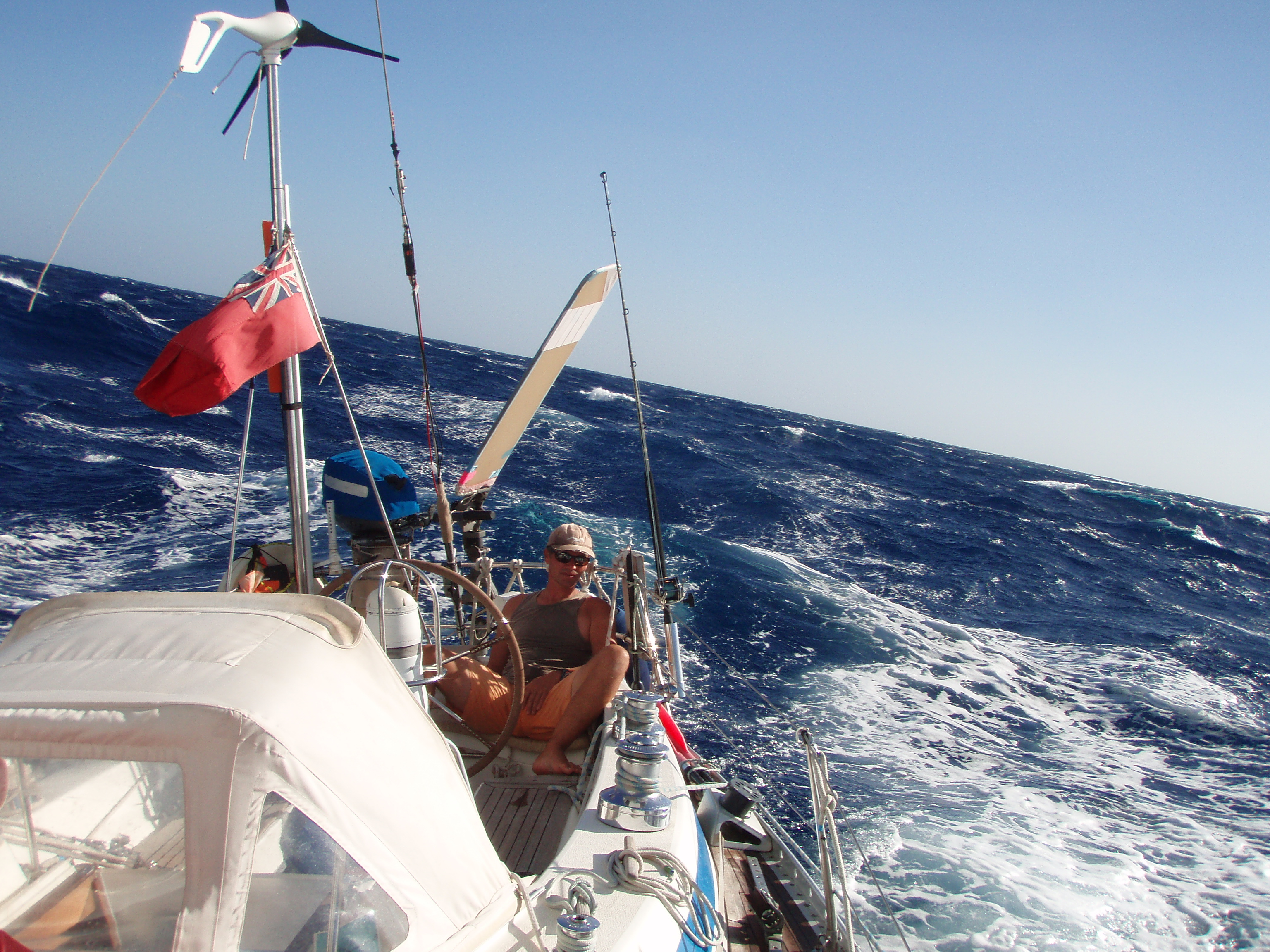
 Bowman 40
Bowman 40
“Well done Hydrovane! We used a well-known servo-pendulum design on our previous boat but suffered annoying problems with line tension and adjustment. Not so with Hydrovane. Truly ‘plug and play’.”
Subject: Outstanding Hydrovane performance
From: Brett Wilson
Date: Wed, September 9, 2009 12:32 am
To: Will Curry
Hi Will!
Your email prompted me to reply and let you know how delighted we have been with the newly-installed Hydrovane on our Bowman 40 this season.
Its performance has been simply outstanding! It was also extremely easy to set up and learn how to use. We simply balanced the sailplan (as usual) and plugged in the Hydrovane. As easy as that!! Excellent performance without any additional messing or fiddling about.
‘Humphrey’ is now a valuable extra crewmember who relieves us of much of the tedious business of having to stand behind the wheel all the time. Until you experience the benefits of good self-steering it is difficult to appreciate the additional freedom it brings. You don’t need to be a blue-water sailor crossing oceans to derive this benefit either. We also use it on much shorter passages of around 50 miles or so when short-handed and delight in the extra freedom it brings.
Well done Hydrovane! We used a well-known servo-pendulum design on our previous boat but suffered annoying problems with line tension and adjustment. Not so with Hydrovane. Truly ‘plug and play’.
Regards
Brett Wilson
Contact
 Mason 44
Mason 44
“I’m currently 700 miles out of San Diego making for Hilo. I’m really pleased with my Hydrovane now that I’ve gotten the sail trim coordinated with the fine tuning capabilities of the steering unit.”
From: Mike Pitts
Sent: September-01-09 10:47 AM
To: Will Curry
Subject: Silverthorne and Her Hydrovane
Will,
It’d been almost a year since I wrote last… I’m finally underway to Hawaii, Marshall Islands, Guam or Palau and on to the Philippines. Choices on further SE Asia stops will be made later.
I’m currently 700 miles out of San Diego making for Hilo. I’m really pleased with my Hydrovane now that I’ve gotten the sail trim coordinated with the fine tuning capabilities of the steering unit. Compared to my past experience with my autopilot, the Hydrovane has fully provided the reliability and confidence levels that I was seeking when I made the purchase.
More Later
Mike Pitts


